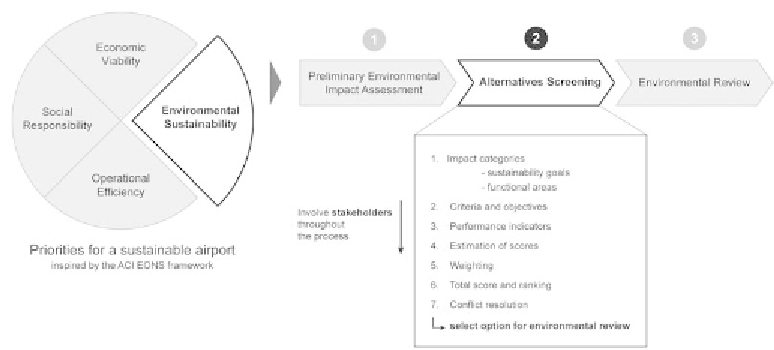Environmental Engineering Reference
In-Depth Information
Figure 1. Role of the evaluation in a generic project development process
the decision-makers on a sustainability commit-
tee in charge of managing the screening process.
The committee would benefit from the modular
structure of the evaluation methodology by se-
lecting only evaluation parameters that are most
pertinent to their particular project. The committee
may also propose specific strategies for achieving
environmental goals. Airport authorities may also
elect to include the method within Environmental
Management Systems (EMS) as defined in the
international standard ISO 14001 (2004).
indices (Balasubramaniam & Voulvoulis, 2005).
Strategies differ as to the scoring of criteria and
the aggregation of individual scores into an overall
ranking of development options. As part of the
present study, we assessed the capability of several
MCA procedures to fulfill our evaluation needs.
Five common MCA procedures, listed in as-
cending complexity, contributed to the rationale of
the procedures suggested in the present evaluation
methodology. For more information on MCA pro-
cedures, see Tsamboulas (1999), Triantaphyllou
(2000), and Tsamboulas & Kopsacheili (2003).
Multi-Criteria Decision Making
Procedure
1.
Performance matrix
: The relative quali-
ties of each option are assessed by direct
performance inspection without scoring
and weighting. The dominant option should
perform strictly better than other ones on at
least one criterion and at least equal in their
performance on all other criteria.
2.
Outranking process
: The concept of
outranking eliminates all alternatives that
are considered dominated. Weights give
more influence to some criteria and define
dominance. Critical threshold values may
be introduced to outrank options that exceed
environmental or regulatory limits.
The aggregation of evaluation parameters is a key
concern in any assessment process. We suggest the
more objective approach of discriminating quan-
titative and qualitative criteria and handling them
with cost and utility functions. The use of Multi-
Criteria Analysis (MCA) brings a structured and
analytic evaluation of each proposal's advantages
and disadvantages and gives consistency to the
decision-making process (Triantaphyllou, 2000).
MCA methods take into account both qualitative
and quantitative measures, which has proven
useful in EIAs for project evaluation, mitiga-
tion evaluation, and the design of environmental

